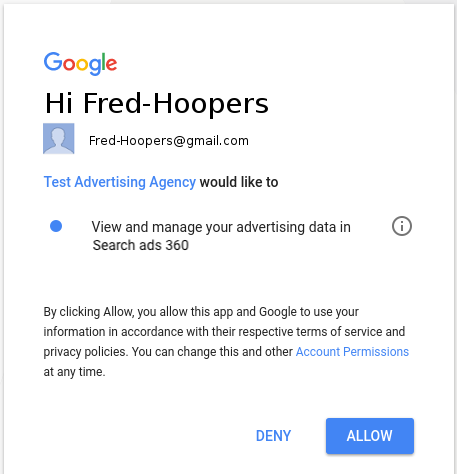Die Search Ads 360 API erfordert, dass alle Anfragen ein OAuth 2.0-Zugriffstoken zur Authentifizierung angeben. Sie können einen beliebigen Standard-OAuth 2.0-Authentifizierungsablauf verwenden, um das Token zu generieren und an die Search Ads 360 API zu übergeben. Wir empfehlen den unten beschriebenen Workflow, da er für vollständig automatisierte Conversion-Uploads und Berichtsdownloads geeignet ist.
Alternativen zum unten beschriebenen Workflow finden Sie unter OAuth 2.0 für installierte Anwendungen verwenden oder
OAuth 2.0 für Server-zu-Server-Anwendungen verwenden. Wenn Sie einen alternativen Workflow verwenden, geben Sie beim Anfordern eines OAuth 2.0-Autorisierungscodes den folgenden Wert als scope-Parameter an:
https://www.googleapis.com/auth/doubleclicksearch
Wenn Sie der Server-zu-Server-Route folgen, fügen Sie das Dienstkonto als Search Ads 360-Nutzer hinzu.
Empfohlener Autorisierungsablauf
- Rufen Sie die Google API Console auf und wählen Sie Ihr Projekt aus.
Wenn Sie noch kein Google API Console-Projekt und keine OAuth-Anmeldedaten erstellt haben, folgen Sie der Anleitung unter Google API Console-Projekt und OAuth-Anmeldedaten für Ihren Kunden erstellen.
So findest du die OAuth-Client-ID und das Secret deines Projekts:
- Öffnen Sie die Seite Anmeldedaten.
- Klicken Sie in der Spalte Name auf den Namen Ihres OAuth-Clients.
- Die Client-ID und das Secret sind auf der Seite aufgeführt.
- Öffnen Sie einen Webbrowser und melden Sie sich mit einem Google-Konto in Google an
, das die Berechtigung zum Zugriff auf Daten in Search Ads 360 hat.
Das ist das Google-Konto, mit dem sich Ihr API-Client bei Search Ads 360 authentifizieren wird. Wenn der Google-Kontoinhaber Ihr Unternehmen verlässt und Sie den Zugriff auf Search Ads 360 für das Konto entfernen, müssen Sie diesen Autorisierungsablauf wiederholen und ein anderes Google-Konto angeben.
- Rufen Sie das Search Ads 360-Dienstprogramm-Script auf, um ein Aktualisierungstoken zu erhalten:
sa360Api.py --loginDas Skript führt Sie durch die Verwendung der OAuth-Client-ID und des OAuth-Secret, um ein Aktualisierungstoken abzurufen. Das Aktualisierungstoken ist nur für das Google-Konto gültig, mit dem Sie sich im vorherigen Schritt angemeldet haben.
Im Rahmen dieses Vorgangs generiert das Script eine URL und fordert Sie auf, die URL in einem Webbrowser aufzurufen.
-
Wenn Sie im Browser aufgefordert werden, dem OAuth-Client Zugriff auf Search Ads 360-Daten zu gewähren, muss das Google-Konto angezeigt werden, in dem Sie sich zuvor angemeldet haben. Wenn Sie in mehreren Google-Konten angemeldet sind, wird möglicherweise ein anderes Konto angezeigt.

Am Ende des Vorgangs gibt das Skript
sa360Api.pyeinen durch Kommas getrennten String aus. Der erste Wert ist die von Ihnen angegebene Client-ID, der zweite Wert der von Ihnen angegebene Clientschlüssel und der dritte Wert das Aktualisierungstoken. In der folgenden Beispielausgabe ist das Aktualisierungstoken fett formatiert:
123456789123.apps.googleusercontent.com,ABCDEFGHIJKLMNOPQR_abcdef,1/HIJklM01OPQR23NOP456rst890uvw - Speichern Sie die Client-ID, den Clientschlüssel und das Aktualisierungstoken in einer Back-End-Datenbank oder an einem anderen sicheren Ort, auf den Ihre Anwendung zugreifen kann.
Bewahren Sie den gesamten kommagetrennten String an einem geeigneten Ort auf, wenn Sie
sa360Api.pyverwenden möchten, um Beispiel-JSON-Anfragen an die Search Ads 360 API zu senden. Sie übergeben den gesamten String jedes Mal als Parameter, wenn Sie das Script aufrufen. - Fügen Sie Ihrer Anwendung Code hinzu, der Folgendes tut:
- Verwende die Client-ID, das Client-Secret und das Aktualisierungstoken, um ein neues OAuth 2.0-Zugriffstoken abzurufen.
- Senden Sie mit dem neuen Zugriffstoken Anfragen an die Search Ads 360 API.
Wenn Sie die Clientbibliotheken verwenden, wird im nächsten Abschnitt Anwendung einrichten beschrieben, wie Sie Ihrer Anwendung diesen Autorisierungscode hinzufügen.
Wenn Sie keine der Clientbibliotheken verwenden, finden Sie unter OAuth 2.0 für installierte Anwendungen verwenden Vorschläge zum Abrufen eines neuen Zugriffstokens.

